Landschlacht, Switzerland, Sunday the Ides of November 2020
The Black Death (also known as the Pestilence, the Great Mortality, or the Plague) was the deadliest pandemic recorded in human history.
The Black Death resulted in the deaths of up to 200 million people in Eurasia and North Africa, peaking in Europe from 1347 to 1351.
The plague created religious, social, and economic upheavals, with profound effects on the course of European history.
Upheavals inspire – art, literature and music.
Examples of Plague art:

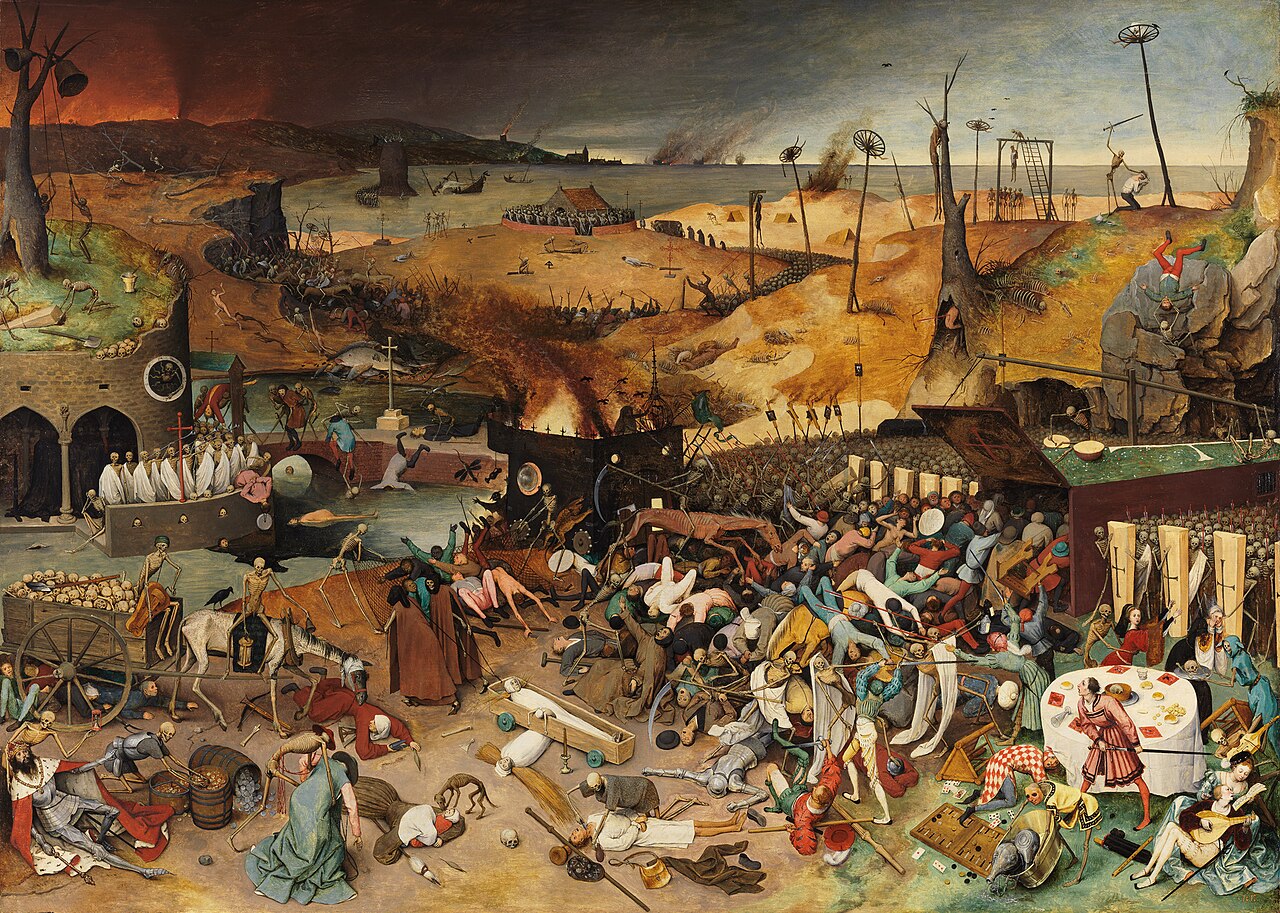


For example in literature, the Black Death inspired:
- A Journal of the Plague Year (1722) by Daniel Defoe describes the Great Plague of Lomdon of 1665 / 1666

- Black Death is a 2010 action horror film set in medieval England in 1348

- The Betrothed (1827) is a plague novel by Alessandro Manzoni, set in Milan.

- Chronicle of Florence is a literary history of the plague, and of Florence (Firenze) up to 1386, by Baldassare Bonaiuti

- Danse Macabre (“Dance of Death“) – an artistic genre of allegory of the Late Middle Ages on the universality of death

- The Decameron (1353) by Giovanni Boccacio is a set of tales told by a group of people sheltering from the Black Death in Florence.

- Doomsday Book (1992) is a science fiction novel by Connie Willis
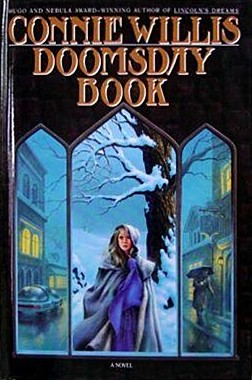
- A Feast in Time of Plague (1830) is a verse play by Aleksandr Pushkin.

Above: Aleksandr Pushkin (1799 – 1837)
- A Litany in Time of Plague is a sonnet by Thomas Nashe as part of his play Summer’s Last Will and Testament (1592)

- The Plague (1947) is a novel by Albert Camus

- The Seventh Seal (1957) is a film written and directed by Ingmar Bergman.

- World Without End (2007) is a novel by Ken Follett.

- The Years of Rice and Salt is an alternate history novel by Kim Stanley Robinson set in a world in which the plague killed virtually all Europeans.

A pandemic is more central to the story of Mary Shelley’s The Last Man, which was published in 1826 but is set in the 21st century.
Amid political turmoil, a group of aristocrats, politicians, minor royals and hangers-on seek refuge from a pestilence that is spreading across the world, until one of them – spoiler alert! – becomes humanity’s only survivor, destined to roam the world alone, just as Frankenstein’s monster did at the end of Shelley’s most famous novel.

Michael Crichton’s 1969 novel The Andromeda Strain is about an extraterrestrial micro-organism which – both terrifyingly and absurdly – doesn’t need a human host to spread.
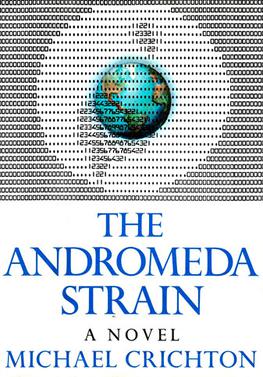
A more artful approach is found in Nobel Prize winner José Saramago’s Blindness, which although published just 25 years ago, has been fast-tracked to classic status.
It depicts an unspecified time and place where people succumb to a contagious form of blindness that reduces the victim’s vision to ‘a milky sea‘.
People suffering are rounded up and put in an asylum, where hierarchies of power develop.
Blindness uses its epidemic as an allegory of society, where life is reduced to a squalid struggle for survival.
Saramago’s novel seems to be evidence of how close society is to collapse when disaster strikes.
But a more optimistic reading – and we need those right now – is that it is really evidence of how robust society is, if it takes an impossible science fiction pandemic to bring it down.

As for music:
The COVID-19 pandemic, also known as the coronavirus pandemic, is an ongoing pandemic of coronavirus disease 2019 (COVID-19) caused by severe acute respiratory syndrome coronavirus 2 (SARS-CoV-2), first identified in December 2019 in Wuhan, China.
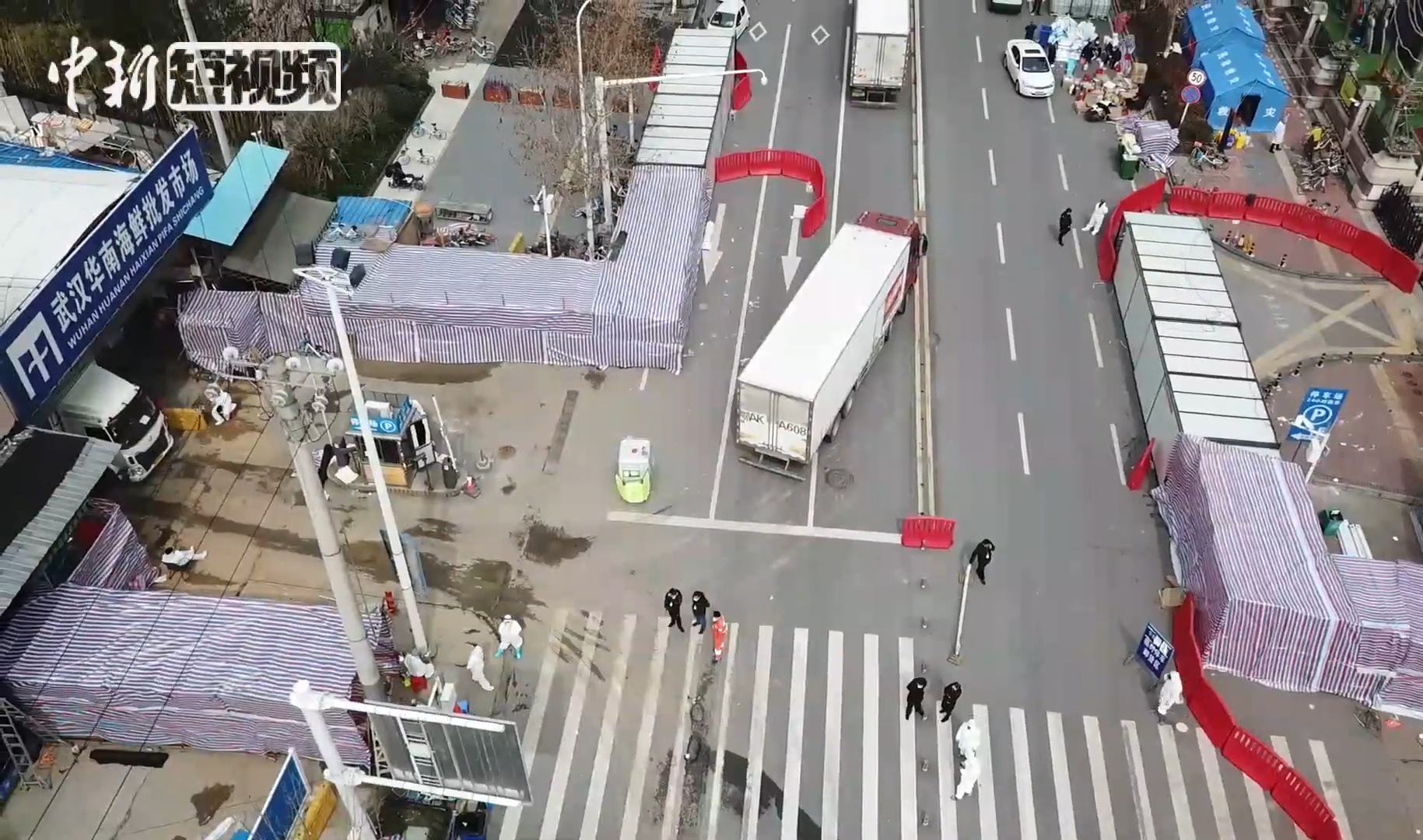
Above: The Huanan Seafood Wholesale Market in March 2020, after it was closed down.
The World Health Organization (WHO) declared the outbreak a Public Health Emergency of International Concern in January 2020 and a pandemic in March 2020.

As of 14 November 2020, more than 53.7 million cases have been confirmed, with more than 1.3 million deaths attributed to COVID-19.
The responses have caused global social and economic disruption, including the largest global recession since the Great Depression.
It has led to the postponement or cancellation of events, widespread supply shortages exacerbated by panic buying, famines affecting hundreds of millions of people, and decreased emissions of pollutants and greenhouse gases.
Educational institutions have been partially or fully closed.
Misinformation has circulated through social media and mass media.
There have been incidents of xenophobia and discrimination against Chinese people and against those perceived as being Chinese or as being from areas with high infection rates.

Above: Map of the Covid-19 verified number of infected per capita as of 15 November 2020 – the darker the region, the more cases therein.
Clearly Covid-19 has created an upheaval in global society, but has it already created similar phenomena in art, music and literature as its predecessor the Black Death had?
We can soon expect to see books inspired by the Covid-19 outbreak, either directly addressing it or more subtly disguised, most likely featuring draconian government powers, tragic personal stories, and the extraordinary surge of community spirit and altruism that we’ve witnessed during this pandemic.
Dramatic times have always inspired great fiction, which will be one small consolation when we come through this.
Lebanese novelist Jabbour Douaihy says the corona virus pandemic, like past epidemics and wars, will feed the imagination of novelists.
“Great authors wrote about previous pandemics and used them as symbols,” he said.

Above: Jabbour Douaihy
Douaihy, who has twice been shortlisted for the prestigious International Prize for Arabic Fiction (IPAF), spoke to AFP as part of their “World Redrawn” series.
He said the novel corona virus “will become part of the general literary scene and the imagination of humanity, just like wars, the plague and other pandemics in history“.

While the virus will change human behaviour, he does not expect it to completely overturn our way of life.
The 71-year-old, with a doctorate in comparative literature from the Sorbonne, is waiting out Lebanon’s corona virus lockdown in the town of Ehden, in the hills above the northern city of Tripoli.

Above: Ehden, Lebanon
Douaihy compared the corona virus to his experience of Lebanon’s 1975-1990 civil war.
“I don’t think the Lebanese war was written about until it was over and done with, meaning it could be used in literature,” he said.
Speaking via the video conferencing app Zoom, he said he was avoiding writing about this period for the time being.
“Writing novels takes time — we can’t write about events that are still taking place,” he said.
But in time, he added, the corona virus pandemic will begin to inspire literature.

He cited French-Romanian playwright Eugene Ionesco’s play “Rhinoceros“, which uses the story of a fictional pandemic to criticise political regimes.

Above: Eugene Ionesco (1909 – 1994)
Albert Camus used his 1947 novel “The Plague“, set in the Algerian city of Oran, to summarise his philosophy on futility, Douaihy added.
The corona virus pandemic “will leave scars and marks on the mind, on the way we think and particularly on the imagination,” he said.

Above: Images of Oran, Algeria
Douaihy, whose novel June Rain was shortlisted in 2008 for the inaugural IPAF, often known as the Arab Booker Prize, made the list again four years later with The Vagrant.
He said he had not been “bothered” by Lebanon’s strict coronavirus lockdown measures, despite finding it hard at first to adjust and to focus on reading and writing.
Douaihy said he did not expect fundamental changes in the worlds of politics, society and economics as the pandemic recedes.

“It’s always said that things will be different after the current crisis, but I’m not sure that human behaviour will change drastically,” he said.
“I tend towards the view that humanity will overcome this pandemic and carry on destroying the environment — although I expect to see some kind of ecological movement emerge,” he said.
“Concern for the environment will grow,” he added.
“It will become clear that we need to return to correct, organic agriculture.“

Above: Flag of Lebanon
Douaihy expects a shift to self-sufficiency and a return to national economies.
Reliance on distance learning and remote education could also grow, affecting global communication and globalisation.
But “the trend of excessive consumption is here to stay and individualism may become stronger,” he said.

The author compared the closure of national borders over the coronavirus to people retreating to their homes.
“We go back to our homes as if they are a refuge from the virus.
States have done the same, trying to shut themselves in,” he said.
“This foresees a retreat from principles the world had tried to promote, such as freedom of movement.“

But while the coronavirus had put the brakes on transnational movement, it was “too early to draw conclusions from that.”
And although the Arab world has not been hit as hard by the virus as Europe and the United States, the region still faces its own crises, he said.
Despite the pandemic, “we still face our normal conflicts, as if nothing had happened.”

Above: The Arab World (in yellow)
The experience of the lockdown with all the accompanying emotions of fear, loneliness and uncertainty may have resulted in the birth of a new genre — lockdown literature.
Some examples are:
- The Day Before Today – Lockdown Stories, by Gayatri Gill

- Leaving and Other Stories – Lockdown Liasons (Book One) by Shobhaa Dé

- Love In the Time of Quarantine by Siddharta Gigoo

Music seems much easier to find, especially parodies on the pandemic using other songs as their inspiration:
But what of art?
Has Covid-19 inspired art?
Does art have any meaning for us in these troubled times?
Does art matter when we are facing a global crisis?

Above clockwise from upper left: self-portrait by Vincent van Gogh / a female ancestor figure by a Chokwe artist / detail from The Birth of Venus by Sandro Botticelli / an Okinawan Shisa lion
Judy Chicago, New York Times columnist, has definite opinions.
“Obviously, there is a great deal of art that doesn’t matter.
This includes the work issuing from those university arts programs that every year pump out thousands of graduates, taught only to speak in tongues about formal, conceptual and theoretical issues few people care about or can comprehend.
Then there is the art created for the global market that has convinced too many people that a piece’s selling price is more important than it content it conveys.“
Ms. Chicago’s education about the potential power of art began in the early 1970s, when she delivered a lecture in Grand Forks, North Dakota.

Above: Grand Forks, North Dakota
It was not a place where one would assume art would matter.
Nonetheless, more than 200 women and men attended Ms. Chicago’s talk.
She showed images from Great Ladies, her series of abstract portraits of some important and forgotten women in history, such as Christina of Sweden, the 17th century queen and patron of the arts who widely influenced European culture.
In the early 1970s, women’s studies as an academic field was in its infancy.
Ms. Chicago had discovered those figures through her own research, driven by a desperate need to find out about women of the past who had faced obstacles like the ones Ms. Chicago had encountered in her career.

After her talk, Ms. Chicago did something artists rarely do:
She asked the audience what they thought of her work.
After a few minutes, someone said Ms. Chicago’s stated aim of depicting significant women in history was interesting, but that without a spoken explanation people would never have been able to understand her work.
That interaction was a revelation.
It inspired Ms. Chicago to figure out how to make the imagery more accessible, starting with The Dinner Party, her symbolic history of women in Western civilization.
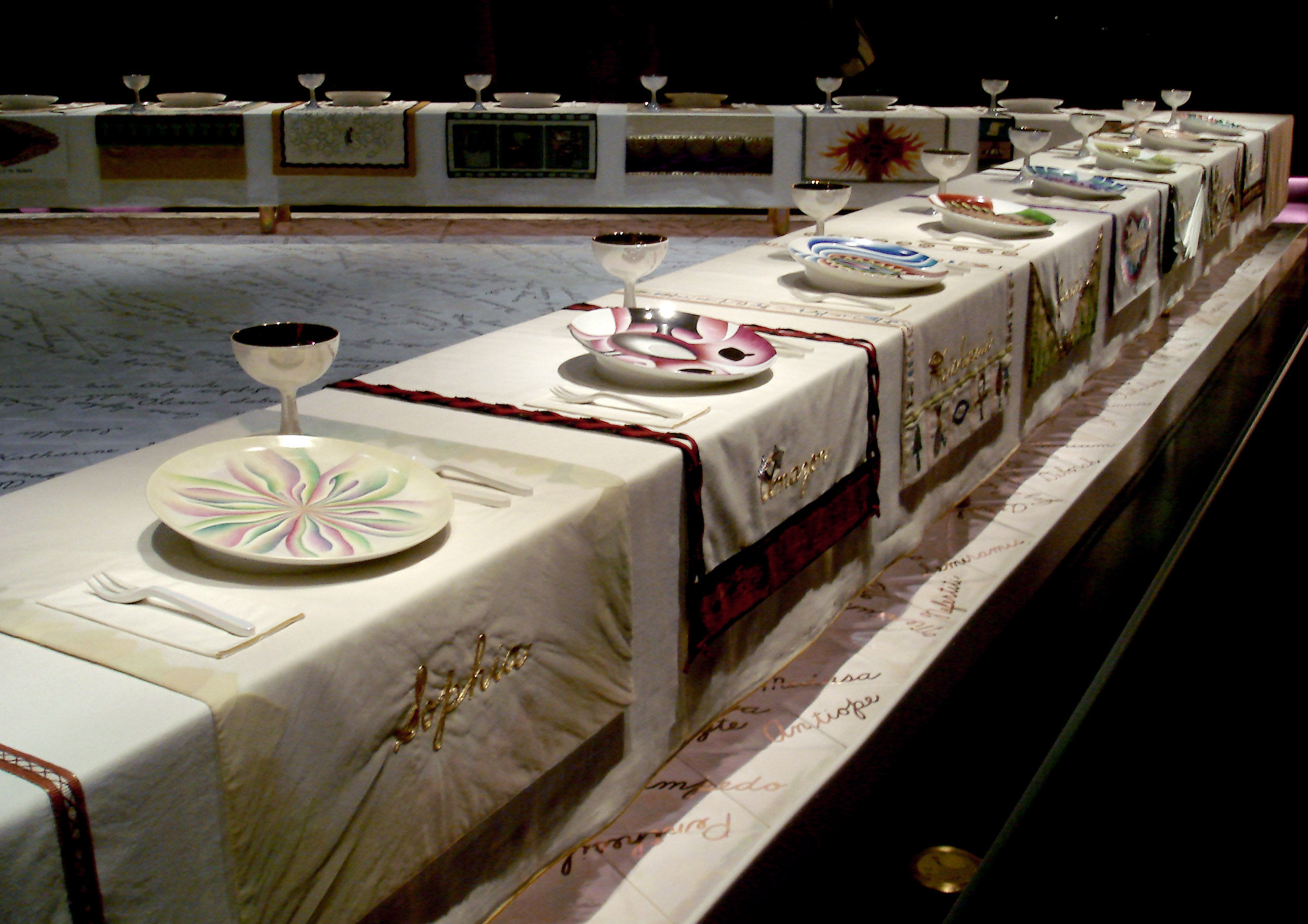
Ms. Chicago believes that because she had structured The Dinner Party so that it could be understood by a broad audience, it was rejected by the art establishment and shunned by the museum system.
But happened next taught her that art could inspire action.
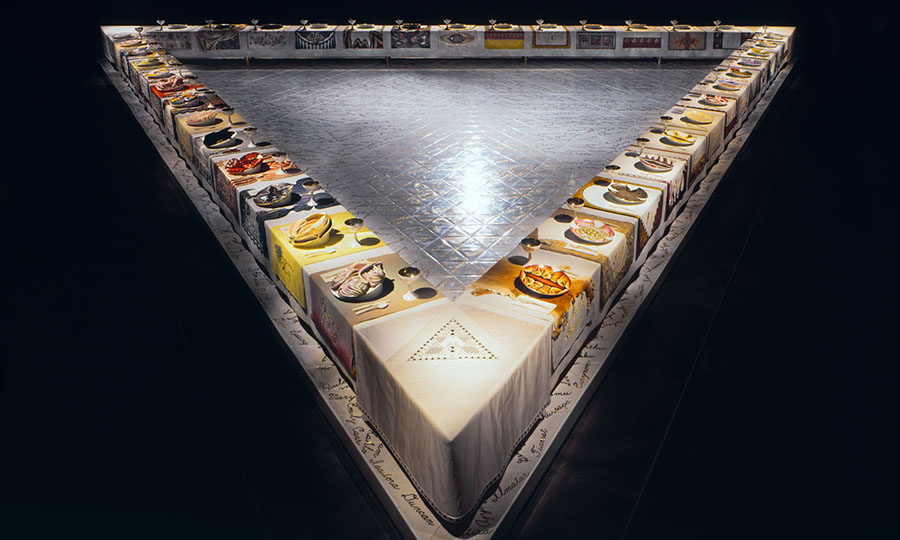
Communities across the US, Canada, Europe and even Australia mounted a phenomenon of grassroots movement, raising money, pressuring public institutions and, when unsuccessful, moving to find alternative spaces to exhibit artwork that they could identify with.
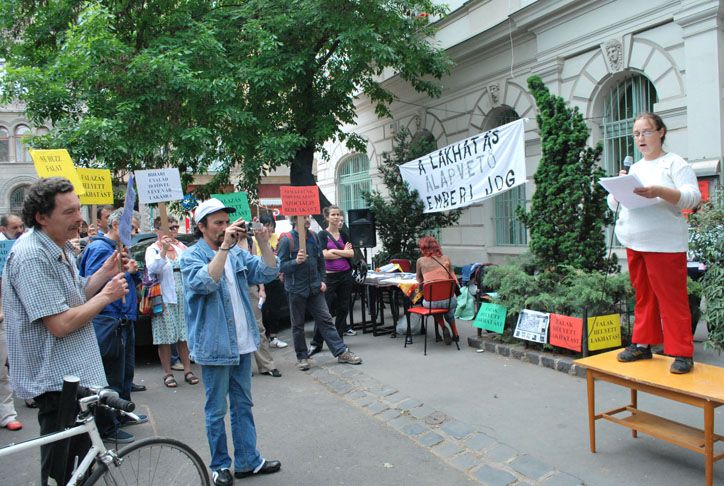
Above: An activist with a local community advocacy organization speaks during a protest against local evictions.
One might ask what Ms. Chicago’s experience has to do with the global pandemic afflicting us.
The answer lies in art’s power to shed light on the problems we are confronted with at this difficult time.
Art can educate, inspire and empower viewers to affect change.
Significant change can only occur if we shift our focus to the work of those artists who have had the courage to show us who we are and ask what are we doing.
Artists like Goya, whose masterpiece series The Disasters of War is a powerful reminder that those who have the least to say about human events suffer the gravest of consequences.

Or take as an example Käthe Kollwitz, whose vivid portraits of the effects of poverty on the working classes should be viewed as part of any discussion of income inequality to more powerfully illustrate what those words really mean.

Art that raises awareness of the state of our planet can be especially important in today’s world.
One example of this is the work of the contemporary artist and illustrator Sue Coe, whose pieces on animal mistreatment have been ignored or, at best, marginalized by an art community that seems to privilege meaninglessness over consequential work.

That is the kind of art that matters most as we confront the devastative force of the corona virus.
Philosopher David Benatar recently wrote in The New York Times that the pandemic is a consequence of our gross maltreatment of animals.

Above: David Benatar
As the primatologist Jane Goodall put it in a YouTube video addressing the outbreak:
“All over the world we have been destroying the places where animals live in order to get materials to build our homes, our cities and to make our lives more comfortable.“
We must wake up, says Ms. Chicago.
This pandemic offers us the opportunity to realize that the path we as humans have taken – a path that has rendered our leaders unable to confront, let alone reverse, climate change or to alter the way we treat our fellow creatures – will result in endless havoc.
Art matters if artists use their talents to help us find our way.

When I consider art I view it as I view religion: a question of interpretation.
Do we see what the artist intended?
What was the artist’s intention?
Did the artist have an intention, a message to impart?
Or do we see in art only who we are and what we want to view ourselves?

Checking Twitter back in March, Michael Tisserand noticed a cat picture that somehow reminded him of the lighting in an Edward Hopper painting.
He realized that was how he was feeling as well, so the writer, who lives in New Orleans, tweeted, along with four Hopper renderings of solitary figures:
“We are all Edward Hopper paintings now.”
“Edward Hopper is one of those artists whose vision of us just becomes part of the way we view ourselves.“

Above: Michael Tisserand
Tisserand’s tweet is among the many Hopper memes that have proliferated on social media.
Another tweet showing a close-up of a Hopper painting of a woman sitting on a bed, staring out a window read:
“We choose modern loneliness because we want to be free, but when the freedoms of modern life are removed, what is left but loneliness?“

But while some Hopper experts appreciate the wave of interests in the American painter, who died in 1967, they say it is a mistake to brand him as a patron saint of loneliness and social isolation.

Above: Edward Hopper (1882 – 1967)
“He didn’t feel a sort of social stigma, or that just becuase you are with yourself that you are not entirely content.“, say Sarah Kelly Oehler, chair and curator of American art at the Arts Institute of Chicago.
“I think that there is some misrepresentation there.“

Above: Art Institute of Chicago
Ms. Oehler’s museum is home to Nighthawks, which overstockart.com recently depicted with the label:
“Hopper, the master of social distancing“
….to illustrate a blogpost about the artist’s work.

An iconic image of the 20th century, it sprang from another period of widespread anxiety.
Hopper began painting it just days after the bombing of Pearl Harbor in 1941.

Above: Photograph taken from a Japanese plane during the torpedo attack on ships moored on both sides of Ford Island shortly after the beginning of the Pearl Harbor attack.
View looks east, with the supply depot, submarine base and fuel tank farm in the right center distance.
A torpedo has just hit USS West Virginia on the far side of Ford Island (center).
Other battleships moored nearby are (from left): Nevada, Arizona, Tennessee (inboard of West Virginia), Oklahoma (torpedoed and listing) alongside Maryland, and California.
On the near side of Ford Island, to the left, are light cruisers Detroit and Raleigh, target and training ship Utah and seaplane tender Tangier.
Raleigh and Utah have been torpedoed, and Utah is listing sharply to port. Japanese planes are visible in the right center (over Ford Island) and over the Navy Yard at right.
US Navy planes on the seaplane ramp are on fire. Japanese writing in the lower right states that the photograph was reproduced by authorization of the Navy Ministry.
Whereas 21st century pandemic shut-ins see a reflection of themselves, Ms. Oehler says Hopper saw something else:
“The great story that he would tell was that this was about imagining what it would be like in a blacked-out city to come across this brightly lit diner with people in it.“, she says.
The artist himself once said of Nighthawks:
“I didn’t see it as particularly lonely.“
He conceded:
“Unconsciously, probably, I was painting the loneliness of a large city.“

In Hopper’s oeuvre, Virginia Meckleburg, senior curator at the Smithsonian American Art Museum, sees affirmation of aloneness is imposed by circumstance.
For those seeing Hopper memes on social media who want to better understand the artist’s work.

Mecklenburg recommends they check out his watercolours, drawings and prints.
“He seemed to have a different persona working in each medium.”, she says.
“By Googling, you will get dozens and dozens of Hoppers that will give you a sense of the breadth and the depth of this guy that you won’t get from looking at a single painting, no matter how iconic it is.“

Michael Lobel, professor of art history at Hunter College and the Graduate Center at the City University of New York, says he understands why the Hopper quarantine memes have taken off.
Many of Hopper’s Paris works, which he made early in his artistic career, do show architecture and cityscapes devoid of people.

There’s even a preparatory sketch that Hopper made, now in the collection of the Whitney Museum of American Art, that portrays the diner in Nighthawks without the four people.
“A major part of his pictorial imagination was to imagine a world or settings without figures at all.“, Lobel says.

Above: Whitney Museum of American Life, New York City
But Lobel thinks the works are less negative or pessimistic than many are interpreting them to be.
And rather than adhere to the “constant drumbeat” around Hopper and alienation and detachment, he advises viewers to look at the spaces, places and architecture in the paintings and in real life to see traces of human presence even when no people are visible.
“That certainly resonates with what’s going on right now, but maybe in a more human or humane kind of way.“, Lobel says.

Certainly, we live in far different times, a time where visuals and audio dominate our attention far more than a text from a shelf or static paintings and sculpture sitting stationary in some museum somewhere.
We are far more greatly interested in video and music for they demand far less of our attention than literature and art.
Our modern, attention deficient souls seem to crave colours and emotion and movement.

Great literature, when time and attention is given, generates our interest, instructs us in how to survive life’s changes, involves us in the lives of the story’s characters, and perhaps even inspires us to do what needs be done and to be all that we can be.
Video, audio, text all sweep us into a tapestry of emotion and experience.
Suspense, empathy, humor, the threat of change, the promise of victory should the hero of the programme, the song, the story be worthy.
But art (and I include photography as part of this) is a moment frozen in time.
Art demands not only our undivided attention, but as well it seeks interaction with us.

Looking at Hopper’s Nighthawks or Sue Coe’s War or Judy Chicago / Donald Woodman’s Half-Scale Study for Double Jeopardy, it is simple to form a facile first impression of what these works evoke in you, the viewer and then simply walk on until something else is seen to draw your attention once again.

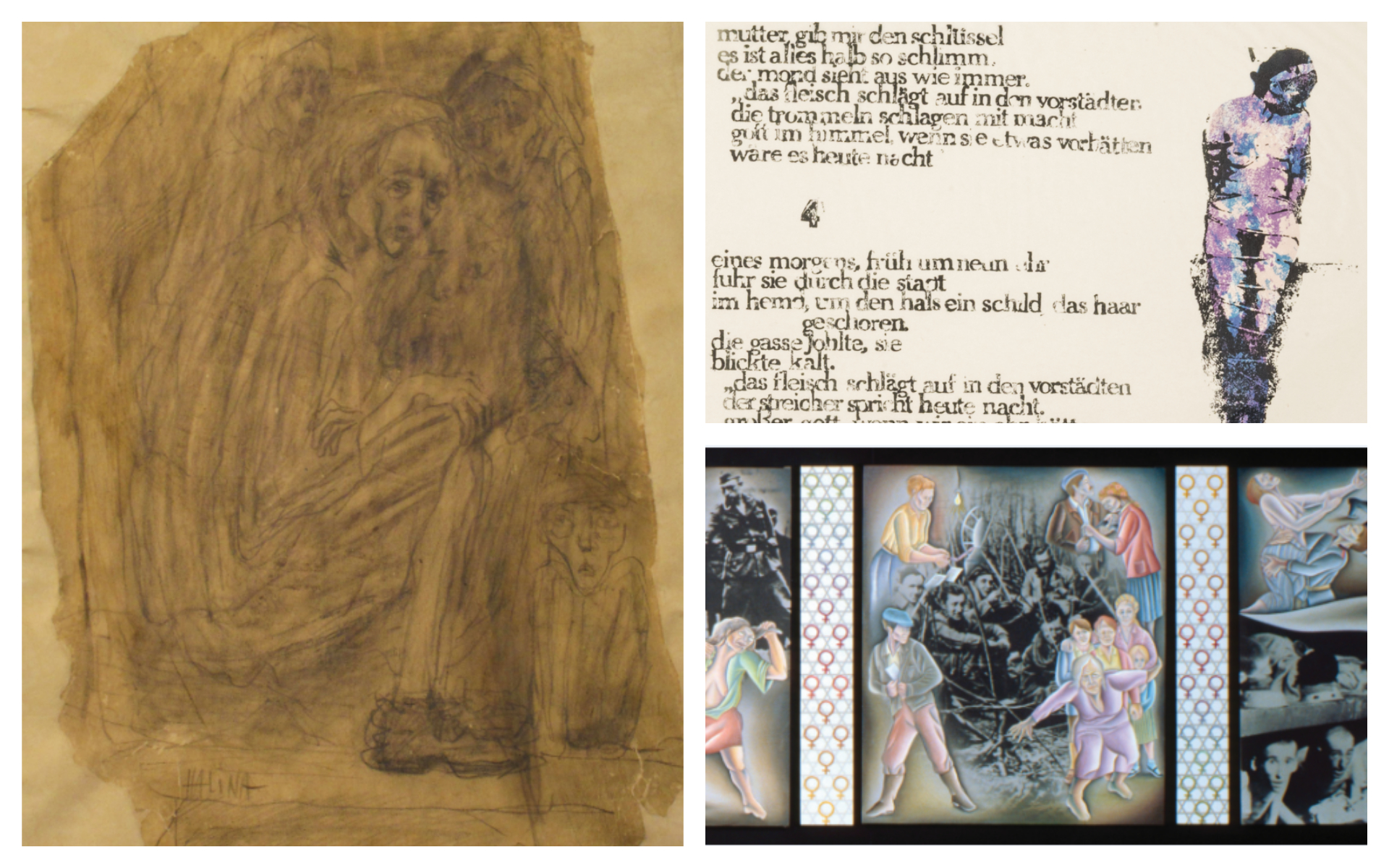
For the weakness of viewing art in a museum is the tendency to be overwhelmed by the number of art pieces on display and the impulse to see without seeing as much as possible in the shortest time, just as one would flipping pages or TV channels, adjusting radio dials or scrolling past Internet posts that haven’t immediately captivated us.
I cannot speak for all artists, but I believe that they are not so different in their desires as writers, broadcasters or videobloggers are.
A painting or a sculpture draws us in within colour and form, but what instruction, involvement and inspiration an artist hopes to provoke must come from us.

The famous fictional detective Sherlock Holmes is often credited with admonished his biographer Dr. John Watson that the good doctor saw without seeing, looked with noticing.
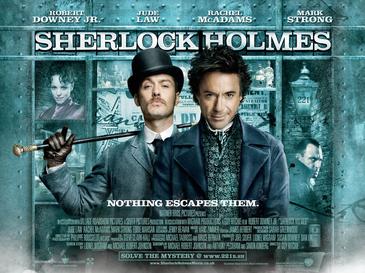
To fully appreciate the frozen moment the viewer needs to imagine.

Night and we see the brilliant interior of a cheap restaurant.
Bright items are the cherry wood counter and the tops of surrounding stools.
There is light on the metal tanks at the rear right.
We see a brilliant streak of jade green tiles 3/4 across the canvas–at the base of the glass of the window curving at the corner.
Light-coloured walls and a dull yellow ochre door lead to the kitchen on the right.
A handsome young blond man in a white coat and cap serves from inside the diner counter.
A brunette in a red blouse eats a sandwich.
A man, a night hawk with a nose resembling a hawk’s beak sits beside her.
He wears a dark suit, a steel grey hat with black band, a clean blue shirt and he is holding a cigarette.
There is another figure, another man, dark profile, sinister silhouette, back to us, sitting to the left across from the silent couple.
Beneath the glow of the eatery lamps a sidewalk reflects the green interior.
Darkish red brick houses opposite seem abandoned, lost in the darkness.
The sign atop the restaurant is a shadow in the dark.
We read “Phillies cigar $0.05“, alongside a picture of a cigar.
Outside the shop are hints of darkest green.
Why are they there?
What led them here?
What will happen next?
What are we to think of the relationship between the nighthawk and the brunette?
Are they on a date?
Are they a couple?
Clearly they are between lines of a dialogue in a conversation that the soda jerk seems interested in.
Is the man across from them a threat or merely a coincidence?
Gottfried Helnwein’s painting Boulevard of Broken Dreams (1984) replaces the three patrons with US pop culture icons Humphrey Bogart, Marilyn Monroe and James Dean, and the attendant with Elvis Presley.
But Helnwein doesn’t quite capture the essence of Hopper’s Nighthawks.
Hopper captures a feeling of anyone anywhere.
Helnwein seeks celebrity from inserting celebrities in Hopper’s famous painting.
Helnwein is the first to imitiate.
He would not be the first.

Several writers have explored how the customers in Nighthawks came to be in a diner at night, or what will happen next.
Wolf Wondratschek’s poem “Nighthawks: After Edward Hopper’s Painting” imagines the man and woman sitting together in the diner as an estranged couple:
“I bet she wrote him a letter
Whatever it said, he’s no longer the man
Who’d read her letters twice.”

Above: Wolf Wondratschek
Joyce Carol Oates wrote interior monologues for the figures in the painting in her poem “Edward Hopper’s Nighthawks, 1942“.
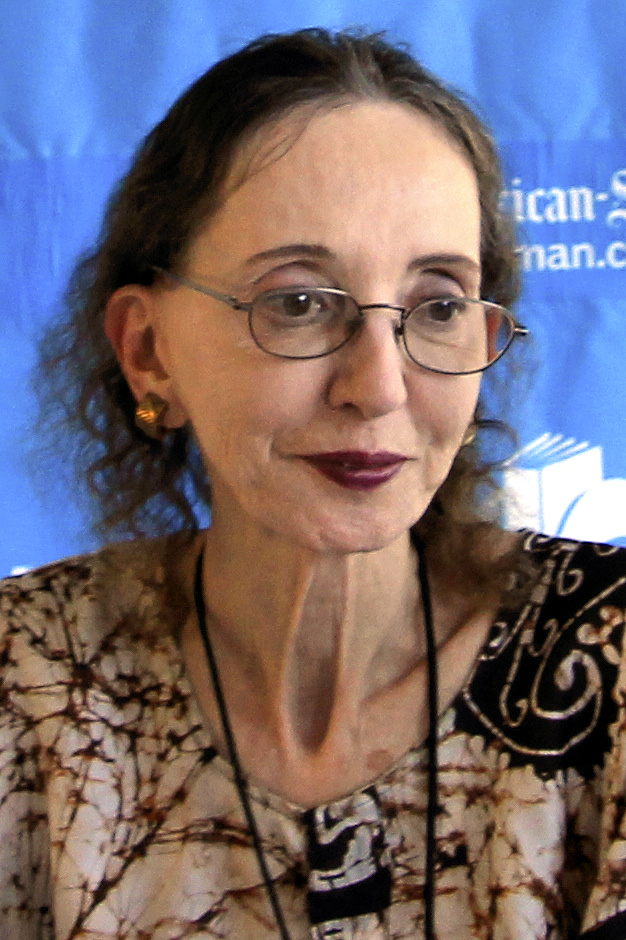
Above: Joyce Carol Oates
A special issue of Der Spiegel included five brief dramatizations that built five different plots around the painting:
One, by screenwriter Christof Schlingensief, turned the scene into a chainsaw massacre.
Erik Jendresen and Stuart Drybeck also wrote short stories inspired by this painting.

Hopper was an avid moviegoer and critics have noted the resemblance of his paintings to film stills.
Nighthawks and works such as Night Shadows (1921) anticipate the look of film noir, whose development Hopper may have influenced.
Hopper was an acknowledged influence on the film musical Pennies from Heaven (1981), for which production designer Ken Adam recreated Nighthawks as a set.

Director Wim Wenders recreated Nighthawks as the set for a film-within-a-film in The End of Violence (1997).
Wenders suggested that Hopper’s paintings appeal to filmmakers because “You can always tell where the camera is.“

In Glengarry Glen Ross (1992), two characters visit a café resembling the diner in a scene that illustrates their solitude and despair.

The painting was also briefly used as a background for a scene in the animated film Heavy Traffic (1973) by director Ralph Bakshi.

Nighthawks also influenced the “future noir” look of Blade Runner.
Director Ridley Scott said:
“I was constantly waving a reproduction of this painting under the noses of the production team to illustrate the look and mood I was after.”

In his review of the 1998 film Dark City, Roger Ebert noted that the film had “store windows that owe something to Edward Hopper’s Nighthawks.”
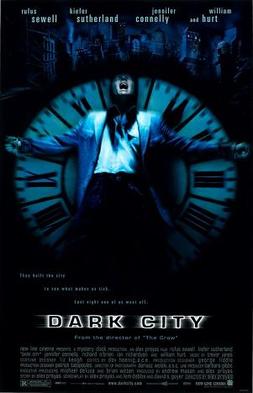
Hard Candy (2005) acknowledged a similar debt by setting one scene at a “Nighthawks Diner” where a character purchases a T-shirt with Nighthawks printed on it.
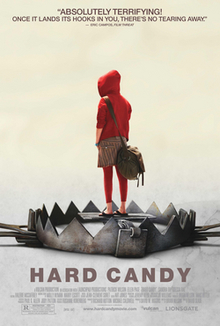
In music:
- Tom Waits’ album Nighthawks at the Diner (1975) features a title, a cover, and lyrics inspired by Nighthawks.
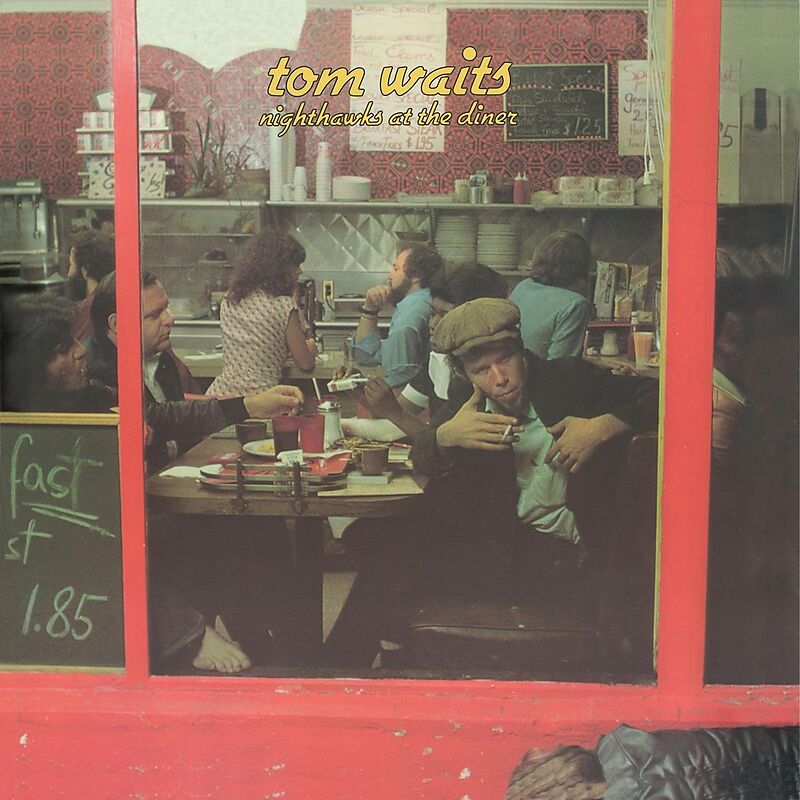
- The video for Voice of the Beehive’s song “Monsters and Angels“, from Honey Lingers, is set in a diner reminiscent of the one in Nighthawks, with the band members portraying wait staff and patrons. The band’s web site said they “went with Edward Hopper’s classic painting, Nighthawks, as a visual guide.”
- Orchestral Manoeuvers in the Dark (OMD)’s 2013 single “Night Café” was influenced by Nighthawks and mentions Hopper by name. Seven of his paintings are referenced in the lyrics.
- Perhaps Don Henley’s Sunset Grill was inspired by Nighthawks.
One single painting has inspired literature, cinema, music, television and model train aficiandos.
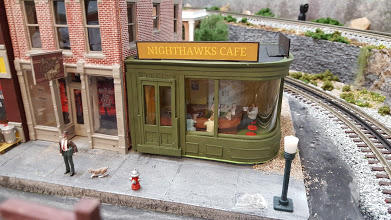
I find myself wondering if our Covid-19 times could very well be one day imitated by a Edward Hopper copy of Nighthawks.
Who would be the server?
Who would be the three patrons?
Would we witness a danse macabre outside on the sidewalk?
How will we choose what to portray or what to feel?
How will we see these times?

Sources: Wikipedia / Google / YouTube / Judy Chicago, “What does art have to do with the virus?“, New York Times, 2 June 2020 / Menachem Wecker, “I think there’s some misrepresentation there“, Washington Post, 27 April 2020